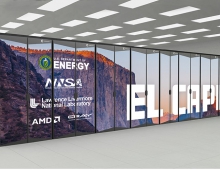
U.S. Intelligence Agency Launches Program to Develop a Superconducting Computer
The U.S. intelligence community has launched a research project to develop a superconducting computer, awarding its first contracts to three major technology companies.
If successful, technology developed under the Cryogenic Computer Complexity (C3) program will pave the way to a new generation of superconducting supercomputers that are far more energy efficient.
"The power, space, and cooling requirements for current supercomputers based on complementary metal oxide semiconductor (CMOS) technology are becoming unmanageable," said Marc Manheimer, C3 program manager at IARPA. "Computers based on superconducting logic integrated with new kinds of cryogenic memory will allow expansion of current computing facilities while staying within space and energy budgets, and may enable supercomputer development beyond the exascale."
The goal of the C3 program is to establish superconducting computing s a long- term solution to the power-cooling problem and a successor to end-of-roadmap CMOS for high performance computing.
While, in the past, significant technical obstacles prevented serious exploration of superconducting computing, recent innovations have created foundations for a major breakthrough. These include new families of superconducting logic without static power dissipation and new ideas for energy efficient cryogenic memory.
A superconducting computer also promises a simplified cooling infrastructure and a greatly reduced footprint.
The energy demands of today's high-performance computers have become a critical challenge for the Intelligence Community that the C3 program aims to address.
During the initial phase of the C3 program, IARPA-funded researchers will develop the critical components for the memory and logic subsystems and plan the prototype computer, with the goal to later scale and integrate the components into a working computer and test its performance using a set of standard benchmarking programs.
IARPA says it has has awarded research contracts in support of the to teams led by IBM, Raytheon-BBN and Northrop Grumman Corporation.
"The power, space, and cooling requirements for current supercomputers based on complementary metal oxide semiconductor (CMOS) technology are becoming unmanageable," said Marc Manheimer, C3 program manager at IARPA. "Computers based on superconducting logic integrated with new kinds of cryogenic memory will allow expansion of current computing facilities while staying within space and energy budgets, and may enable supercomputer development beyond the exascale."
The goal of the C3 program is to establish superconducting computing s a long- term solution to the power-cooling problem and a successor to end-of-roadmap CMOS for high performance computing.
While, in the past, significant technical obstacles prevented serious exploration of superconducting computing, recent innovations have created foundations for a major breakthrough. These include new families of superconducting logic without static power dissipation and new ideas for energy efficient cryogenic memory.
A superconducting computer also promises a simplified cooling infrastructure and a greatly reduced footprint.
The energy demands of today's high-performance computers have become a critical challenge for the Intelligence Community that the C3 program aims to address.
During the initial phase of the C3 program, IARPA-funded researchers will develop the critical components for the memory and logic subsystems and plan the prototype computer, with the goal to later scale and integrate the components into a working computer and test its performance using a set of standard benchmarking programs.
IARPA says it has has awarded research contracts in support of the to teams led by IBM, Raytheon-BBN and Northrop Grumman Corporation.




















